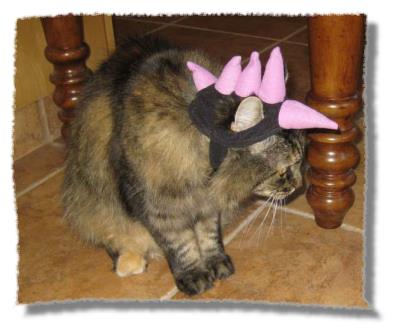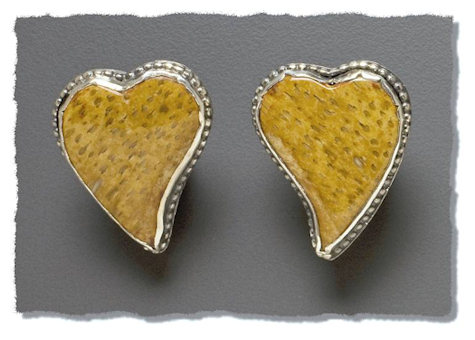These earrings consist of lovely bits of fossilized palm wood which Gary cut into pretty hearts. The ancient palm that made these earrings did not disintegrate when it fell, rather over time silica replaced the organic matter (technically through the pseudomorphosis of chalcedony after wood) leaving a hard (~7.5) form of chalcedony.
At the time I wrote this paragraph, the following information was current (biology continues to advance by the minute, you might want to check this information if you have an interest). Palm trees are monocotyledonous (i.e., having one seed leaf) flowering plants. They first appear in the fossil record during the late Cretaceous, around 80 million years ago, and diverged from the other monocots early in their evolution. They are monophyletic meaning that all palms today arose from a common ancestor. The interesting little spots in the material are the vascular bundles. Palm trees differ from other trees quite markedly. Most trees, as I'm sure you know, have a growth layer (cambium) between the bark and the woody interior. Xylem and phloem are the conduits for water and nutrients, the xylem tissue is inside of the cambium layer while the phloem tissue is outside it. "Wood" is mostly dead, dried out xylem tissue. Most trees display "growth rings" in their wood marking xylem growth. In contrast, palm trees don't have a vascular cambium, they don't display concentric annual rings. Instead they have scattered vascular bundles of xylem and phloem tissue surrounded by a bundle sheath, and that bundle structure remains evident in this fossilized material.
Petrified palm is the state fossil of Louisiana. Apparently nobody knows why this particular material was chosen, but during the debates in 1976 one of the legislators nominated Senator Egdar Mouton of Lafayette for the honor. He declined in deference to "age, rather than beauty." It is also the state stone of Texas (Texas has a state dinosaur but not a state fossil). The hearts likely came from Texas, Louisiana or Mississippi where fossilized palm is quite common. There are arguments as to when it formed, perhaps in the Oligocene (20-40 MYO) or perhaps earlier.
This line of research led me to discover that California doesn't have an official state dinosaur so Sombrita suggested I nominate her. (Don't be angry with me, she liked hats!)


To get back to the earrings, The Book of Stones has an entry for petrified wood and Simmons indicates that it is a stone of patience, of slow, steady growth towards spiritual transformation. He indicates it is good for strengthening the body and stabilizing the spine. Ahsian adds that it assists in connecting with one's ancient roots. I hope these little stones will whisper ancient secrets to you of everlasting love.



